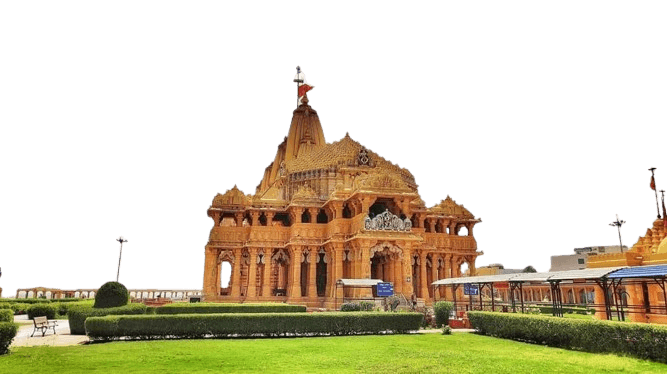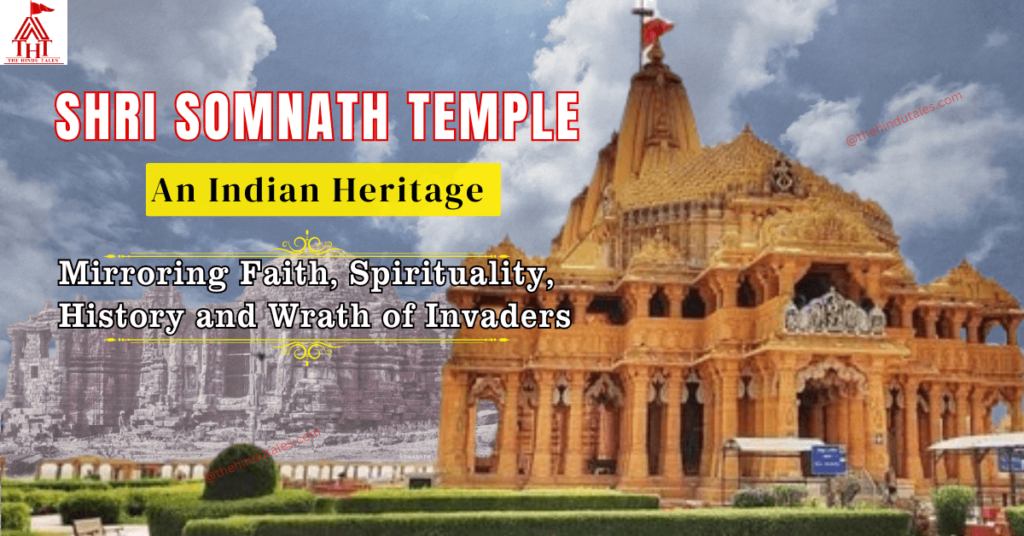Introduction
India is home to some of the rarest and most historic temples in the world. Take for Example – Shri Kailasha Temple Ellora, Sun Temple Konark, etc. These temples are not just a place of worship but more than that they are the living embodiment of our ancestor’s knowledge, wisdom, architectural mastery, and human excellence.
Somnath Temple of Gujarat is such an Indian heritage that played a key role in shaping India’s history. The temple is believed to be 2000 years old, standing alive to tell India’s glorious past and the bloodied history painted with invasion, destruction, and loot. The temple was attacked and destroyed many a time but divine energies associated with the temple defeated these dark forces and showed the world the power of Hindu Faith and devotion. This article offers complete insight into Somnath Jyotirlinga Temple, and its significance, and also guides you in planning your trip to Somnath effectively.
About Shree Somnath Jyotirlinga Temple
Shree Somnath Jyotirlinga Temple is the first of all 12 jyotirlingas in India. It is situated at the Somnath Mandir Rd near Prabhas Patan in the Veraval city of Gir Somnath District in Gujarat state of India. The temple is also famous with the name Deo Patan.
The beautiful honey-colored temple has been carved incredibly in Chalukya Style and is devoted to Lord Shiva. He is the main deity who resides in the form of Shivling in the temple and is believed to have emerged here by himself.

Understanding The Etymology Of The Word ‘Somnath’
Somnath is composed of two words – Som and Nath. The word ‘Som’ is the Sanskrit name for Lord Moon (Chandradev) and the Sanskrit-originated word ‘Nath’ means Master. Therefore the term ‘Somnath’ refers to Lord Shiva because he bears Lord Moon on his forehead.
How It Became The First Jyotirlinga Where Lord Shiva Appeared Himself? – The Story Behind
According to the legends associated with the temple and the place, Lord Shiva appeared here himself to let Lord Chandra (Moon) get rid of the Daksha’s Curse.
Daksha Prajapati was accredited as the son of Lord Brahma whose 27 daughters had married Lord Chandra. But, among all, Lord Chandra was devoted to only one – ‘Rohini’ and was less attentive to others. Knowing this fact, Daksha Prajapati cursed Lord Chandra to fade his luster and beauty. Hence, to get rid of his father-in-law’s curse, Lord Chandra came to this place – Prabhas Patan, and did ‘Tapas’ to impress lord shiva.
Lord Shiva, after getting impressed with Lord Chandra’s devotion and faith, appeared here at this place and blessed Lord Chandra to regain his lost beauty. Lord Chandra became so delighted after getting Lord Shiva’s blessing and established a Shivalinga at this place. Therefore, Lord Shiva here is worshipped as ‘Somnath’ and the temple is revered as ‘Somnath Temple’.
How To Reach Somnath Temple?
Somnath Temple is situated at the Somnath Mandir Rd near Prabhas Patan in the Veraval city of Gir Somnath District in Gujarat state of India. Therefore, Veraval is the main city that should be reached through any means. The city is well connected with all other parts of India through air, train, and road.
Reach Somnath By Air
DIU Airport (DIU) – It is the nearest airport to Somnath temple at a distance of 85 km. But the airport is a domestic airport and hence can be reached through domestic flights only. After landing at Diu you can take a taxi or regular buses available all the time.
Rajkot International Airport (HSR) – It is also a good option for air travelers to land for Somnath Temple Visit. The distance of it from Somnath temple is about 200 km by road.
Sardar Vallabhbhai Patel International Airport, Ahmedabad (AMD) – It is an international airport that is well connected through major parts of the world. Therefore, if you are traveling internationally for the Somnath Temple Visit, you can go with this option also. The distance between the airport and Somnath Temple is about 400 km. Hence, you need to travel either by train or by road to reach Somnath Temple.
Reach Somnath By Train
Somnath Railway Station (SMNH) – Somnath Railway Station with station code SMNH is about 0.5 Km from the Somnath Temple. You can get the train to SMNH from AMD airport as well as HSR airport.
Veraval Junction Railway Station (VRL) – Veraval Junction Railway Station with station code VRL is about 7 Km from the Somnath Temple. Like SMNH the trains from Rajkot as well as AMD are available to this station.
Reach Somnath By Road
By Road From Ahmedabad – The Somnath Temple from Ahmedabad is at a distance 410 km in the South-west direction. Therefore, if traveling from Ahmedabad to Somnath by road then NH 47 is the best route to take.
By Road from Rajkot – The Somnath Temple lies in the west of Rajkot. Therefore you can take NH 27 from Rajkot to Junagadh and from Junagadh take NH 151 (Junagadh Bypass) to reach Prabhas Patan.
Somnath Temple Distance Chart From Other Cities In India (Approximate)
| Cities | Distance (in Km) |
| Gandhinagar to Somnath Distance | 450 – 500 |
| Jamnagar to Somnath Distance | 230 – 250 |
| Porbandar to Somnath Distance | 130 – 150 |
| Dwarka to Somnath Temple Distance | 230 – 260 |
| Veraval to Somnath Temple Distance | 7 – 10 |
| Junagadh to Somnath Distance | 90 – 100 |
| Rajkot to Somnath Distance | 200 – 210 |
| Bhavnagar to Somnath Distance | 270 – 300 |
| Surat to Somnath Distance | 450 – 500 |
| Ahmedabad to Somnath Distance | 400 – 420 |
| Vadodra to Somnath Distance | 470 – 490 |
| Nasik to Somnath Distance | 600 – 700 |
| Mumbai to Somnath Distance | 700 – 750 |
| Diu Airport to Somnath Temple distance | 80 – 90 |
| Indore to Somnath Distance | 790 – 800 |
| Ujjain to Somnath Distance | 800 – 820 |
| Udaipur to Somnath Distance | 700 – 800 |
| Pune to Somnath Distance | 820 – 850 |
| Delhi to Somnath Distance | 1400 – 1500 |
Nearby Places to Visit
Around the Somnath Temple, there are many historic and sacred places to drive you into spirituality. Here are some top attractions around the Somnath Temple that you can visit to experience the divinity of the place.
Ahalyabai Temple
Ahalyabai Temple is situated just near to Somnath Temple. According to the histories, Ahalyabai Holkar built this Shiv Temple in the 17th Century as a substitute for the main Somnath Temple. The temple is painted in Pink and has a rush-free and serene atmosphere.
Bhalka Tirth
Bhalka Tirth is the place where Lord Krishna took his last breath after being wounded by the arrow of a hunter while he was resting under the Peepal Tree. It is at a distance of 4 km from the Somnath Temple.
Shashi Bhushan Temple
Shashi Bhusan Temple is a Shiva Temple situated near the Ban Ganga. It is located near the Somnath Temple on the way from Somnath Temple to Bhalka Tirth. The distance of it from Somnath Temple is about 4 km.
Banganga
Ban Ganga is a significant place because at this place the Hunters who attacked with arrows to Lord Krishna bathed and worshipped Lord Shiva before going on a hunt. It is situated at the seashore and is a major attraction for pilgrimages because of two Shivlinga in the shallow water of the Arabian Sea. You can worship the Shivling during low tide when it is visible.
Triveni Mahasangam Ghat
Triveni is a Sanskrit Word which means generally the confluence of three rivers. The Triveni Mahasangam Ghat is the meeting point of three holy rivers: Hiran, Kapila, and Saraswati. The Ghat is located at a distance of 1 km from Somnath Temple and hence can be reached easily. The popular belief about Triveni Sangam is that whoever bathes in the holy water of Sangam attains Moksha (The Hindu Philosophy of getting liberation from the earthly cycle of Birth and Death).
The other Triveni Sangam is located in Prayagraj, Uttar Pradesh where three holy rivers Ganga, Yamuna, and Saraswati meet at Sangam Nose. Similar to Mahasangam Ghat, Triveni Sangam Prayagraj is also sacred for Hindus and regarded as the ‘King of All Pilgrimage’.
Golokdham Tirth
Golokdham Tirth also Known as Dehotsarg Tirth is a significant pilgrimage site in Gujarat. The Sanskrit word Dehotsarg means ‘sacrificing the mortal body‘.
The popular belief about this place is that Lord Krishna after getting hit by an Arrow came to this place from Bhalka and left the Earth there. It is situated on the bank of the Hiran River at a distance of 2 km from Somnath Temple. The footprint of Bhagvan Shree Krishna is carved here to mark the divine memory of Shree Krishna Neejdham Prasthan Leela.
Tips For Visiting Nearby In Veraval
Planning a tour to any destination is an exhausting process that consumes our energy before we can enjoy the vacation, isn’t it? But, how about if you learn the process from other’s experience and apply it to your journey? This will not only save your efforts and time but also money.
The following tips and tricks can be a savior in mitigating your hustle to visit the nearby places in Veraval and Somnath Temple. Learn these tips if visiting the Somnath Temple for the first time.
Tirth Darshan Bus facility: The Bus facility is available at a nominal charge which takes pilgrims to the Nearby Temples for Darshan. The Bus Leaves from the Main Gate of the Temple and Its Timings are 08:30 AM and 03:30 PM.
Shared Auto in Reserve Mode: If you are a group of devotees and traveling together, then reserving a shared auto is a wise move to save you from hassle. It will also save your pocket from burning unnecessarily. The shared auto is available easily outside the temple and will come into your budget. The amount of reservation depends on the negotiation however if roughly calculated it will cost you between Rs. 300 to Rs. 500.
Why Should You Visit Somnath Temple?
The importance of Somnath Temple is not just for the sake of religious purpose but its key significance rolls over India’s history and dramas.
Historical Significance
The temple’s historical significance opens up an unseen chapter of Indian history that is covered up with many attacks, bloodshot cruelty, Loot of the temple’s wealth, and the destruction of temple properties by the Muslim Invaders.
Muhamad Ghazni, a fanatic Islamist, with evil intentions, attacked the temple 17 times and looted, and destroyed a part of the temple each time. His Final attack was in 1025-26 CE when he made the greatest destruction to the temple killing about 50, 000 Hindus approximately.
It was such a dark chapter in India’s history when the Hindus faced genocide in their own motherland. The event was also drastic in a way that no Hindu ruler ever harmed Muhammad Ghazni or challenged his reign but still the Hindus were forced to see the killings and destruction of their people and temples.
However, after each attack, the temple was rebuilt and adorned with faith and devotion again by the Hindus, defeating the evil intentions of fanatics, all the time.
The latest attempt to reconstruct the temple was made by Sardar Vallabh Bhai Patel (the then Home Minister of India) in 1954. It was a remarkable step by him to restore India’s lost cultural identity. The visionary man identified that rebuilding the ‘Somnath Temple’ could help revive India’s lost esteem and boost Indians’ confidence.
Religious Significance
Somnath Temple is considered to be the First Jyotirlinga among the 12 Jyotirlingas in India. A Jyotirling is the self-appeared manifestation of Lord Shiva. Therefore, in this respect, the place where Lord Shiva first appeared on Earth in the form of Shivalinga is ‘Somnath’.
Thus, the Somnath Temple is very sacred to Hindus because of its pure and powerful connection with Lord Shiva.
Best Time to Visit Somnath Temple?
The best time to visit Somnath Temple is around the year. But, keeping in mind the weather suitability and ease of transportation, the winter months from October to February are most preferred. You can experience the serene beauty of Patan at this time which can fill you with pure energy and devotion.
However, if you can visit the temple on some auspicious occasion like ‘Shivaratri’ or ‘Kartik Purnima’, it can add up to a mesmerizing experience that will be cherished for a lifetime.
Conclusion
Rising time and again, from the ashes of destruction, the Somnath Temple is a live example of India’s resilient testament, unwavering Hindu faiths, and pure devotion. More than just an architectural marvel, the temple transcends India’s historical journey and our attempts to defeat wicked and evil forces. It is the soul of India’s spirituality and a living proof of Sanatan Dharma’s eternal glory. So, whatever attempts the haters of Sanatan can make to dent our pride, we will stand by time again with double the power and enthusiasm to restore our pride.
FAQs
Q1. Where is Somnath Temple?
Ans. The Somnath Temple is situated in Patan at Somnath Mandir Road, in the Veraval city of Gujarat. The city falls in the Gir Somnath district and is an important pilgrimage site.
Q2. Who built the Somnath Temple?
Ans. Somnath Temple was built time and again after each destruction under a different reign. However, the present temple’s construction was initiated by Sardar Vallabh Bhai Patel in 1954 after India’s independence.


